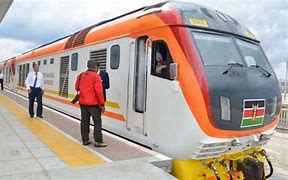
Kenya’s China-built railway is a hot-button issue new government must address to halt economic drain
Fireworks popped and confetti rained down in the seaside city of Mombasa when Kenya’s president inaugurated the country’s new railway — designed, funded and built by China.
President Uhuru Kenyatta proclaimed that the new train would connect the port in Mombasa to the neighbouring country of Uganda, create jobs and help transform Kenya into an industrialised, middle-income nation.
“This is a very historic moment,” President Kenyatta, waving a giant Kenyan flag, told the gathering of Kenyan and Chinese officials. “We should be proud.”
That was five years ago. The railway has since turned into a fiasco, the target of lawsuits, criminal investigations over corruption and resentment by environmentalists and displaced workers in the trucking industry.
Now, it’s a hot-button issue in the closely contested election on Tuesday and part of a broader debate about China’s expanding role in Kenya. The leading candidates have proposed everything from deporting Chinese workers doing local jobs to renegotiating the onerous debt Kenya owes China. But for many, it’s the railway, which cost a whopping $4.7 billion, that has come to embody the corruption and greed among the political elite.
China initially financed the railway as part of its trillion-dollar Belt and Road Initiative, which aimed to expand China’s economic and political clout by funding new ports, roads and railways globally. But China baulked at financing the last section of the Kenyan railway – the connection to Uganda – as some African countries struggled to repay their debts.
The train’s tracks run 367 miles from Mombasa through the capital, Nairobi – and end abruptly in an empty field in the Rift Valley, more than 200 miles from Uganda.
“The SGR is an economic, social and fiscal disrupter,” said Tony Watima, an economist, referring to the Standard Gauge Railway, which Kenyans call the train. “The disruption it has created in the Kenyan economy will be felt for years.”
Both leading candidates in the campaign to pick Kenyatta’s successor – William Ruto and Raila Odinga – have seized on the railway’s troubles, promising to reassess its operations, while also trying to distance themselves from the project.
Ruto is the deputy president and part of the administration that launched the railway. In an interview, he acknowledged that Kenya’s public debt – a total of $73.5 billion as of March in a country with a gross domestic product of just over $100 billion – was creating a “very precarious” situation, and that the railway had so far failed to expand the economy.
“We are hurting from paying the Chinese debt,” he said.
His opponent, Odinga, is a former prime minister who had long been critical of the project and accused Kenyatta’s family of benefiting from it. But now that Kenyatta is backing him, Odinga has softened his criticism, while promising to overhaul the railroad’s operation. He told a crowd of supporters in Mombasa recently, “Once I am in office, we will fix it.”
The railway represents the height of the borrowing and looting spree that has plagued Mr. Kenyatta’s government since it took office in 2013, economists, analysts and government officials said in interviews. His administration, they said, has saddled the country with large-scale infrastructure projects that are not financially viable, largely benefit the wealthy and divert investments from education and health care. In the past nine years, Kenya’s public debt has surged almost fivefold.
“The standard gauge railway is the jewel in the crown of corruption in Kenya,” John Githongo, a former anti-corruption czar, said. “That’s a sad legacy of the current regime.”
Mr. Kenyatta’s office did not respond to emailed questions for this article. The government’s minister for treasury and planning, Ukur Yatani, who oversees the country’s port, rail and pipeline infrastructure, did not reply to requests for an interview.
The railway’s financier, Exim Bank of China, has demanded reimbursements, even as creditors like France and Japan gave Kenya some respite from servicing their loans because of the pandemic. To repay the loan, the government introduced a raft of taxes and austerity measures that have angered the public, which is coping with rising food and fuel prices stemming from a drought and the war in Ukraine.
There was a “lack of economic planning and foresight” in commissioning the railway, said Abdullswamad Shariff Nassir, a lawmaker who leads the public investments committee in Parliament.
For years, Kenya deliberated about whether to build a new railway or renovate its century-old line built by the British colonialists and famously known as the “Lunatic Express.”
Independent reports, including from the World Bank, recommended upgrading the existing rail network as a cheaper option. But ultimately, the Kenyatta administration settled on building a new one: a standard-gauge railway on which freight trains could run at 50 miles per hour and passenger trains at 74 miles per hour.
- The New York Times report











